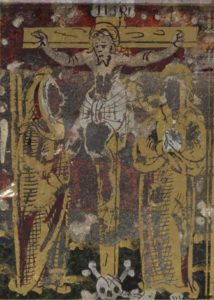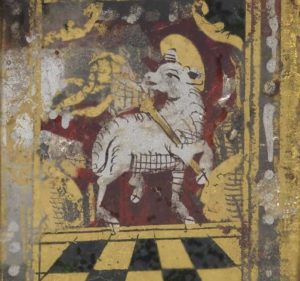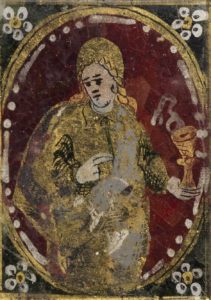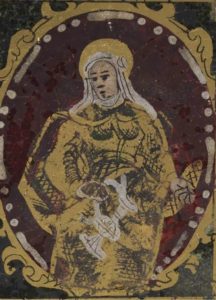The iconography of the pendant raises further questions. What are the images depicted in the glass panels? How are they related to one another? And do they provide any clues to how this pendant would have been used or worn by its original owner?
Decoding the Pendant’s Iconography
There are four reverse-painted glass panels set on the back and front of the pendant. On the front cover is an image of the crucifixion, with Christ in the centre flanked by his mother Mary and the Apostle John.
The inside left panel depicts the Lamb of God (or Agnus Dei)—an ancient symbol for Christ, the “sacrificial lamb” whose death atones for the sins of the world. The lamb holds a resurrection banner, a traditional symbol of Christ’s triumph over death; and, as the panel is placed directly behind the crucifixion, it suggests a narrative link between the first two panels, between death and resurrection.
The third panel, located on the inner right side of the pendant, shows a haloed man holding a cup with an indistinct white shape rising from it. This odd shape is a serpent, and the figure is St John the Evangelist, who is said to have survived an attempt on his life by drawing out the venom from a poisoned cup given to him by his enemies.
The image on the back panel is more enigmatic. It appears to be Mary Magdalene with the alabaster jar, who, like John the Evangelist, is beloved of Christ and witness to the resurrection. However, the elongated jug in her hand differs from the usual ointment jar associated with the Magdalene, and her simple headdress is a clear departure from the long hair that makes her such a distinctive iconographic figure. At the same time, there is no symbol linking this figure to an alternative saint. The woman is probably Mary Magdalene, but we cannot say for certain.
The Possible Contents and Uses of the Pendant
Without a clear sense of its origins, it is difficult to know what would have been kept in this pendant. It was most likely a reliquary, but alternatively, it may have contained a prayer, a tiny codex, or an Agnus Dei (a small wax seal of the Lamb of God blessed by the Pope).
To arrive at any clear sense of its contents, we would have to ask more questions about how it was used: was it worn as jewellery? Or would it have hung in a chapel? Could the pendant have been a decorative attachment to a rosary? Again, we can only speculate as to the possible contents of this miniature book-shaped object. The function of this pendant remains a mystery.

Back to A 17th Century Pendant





